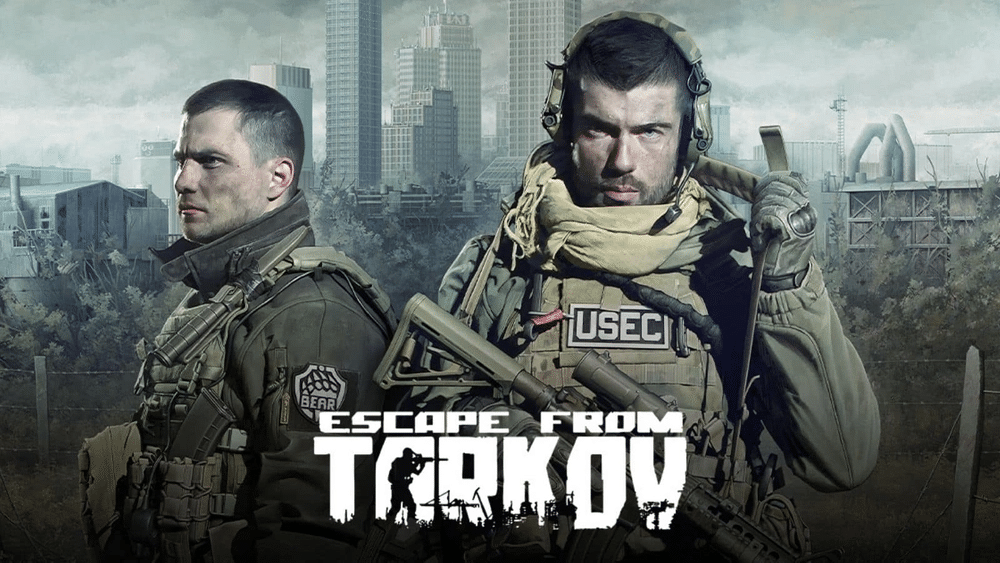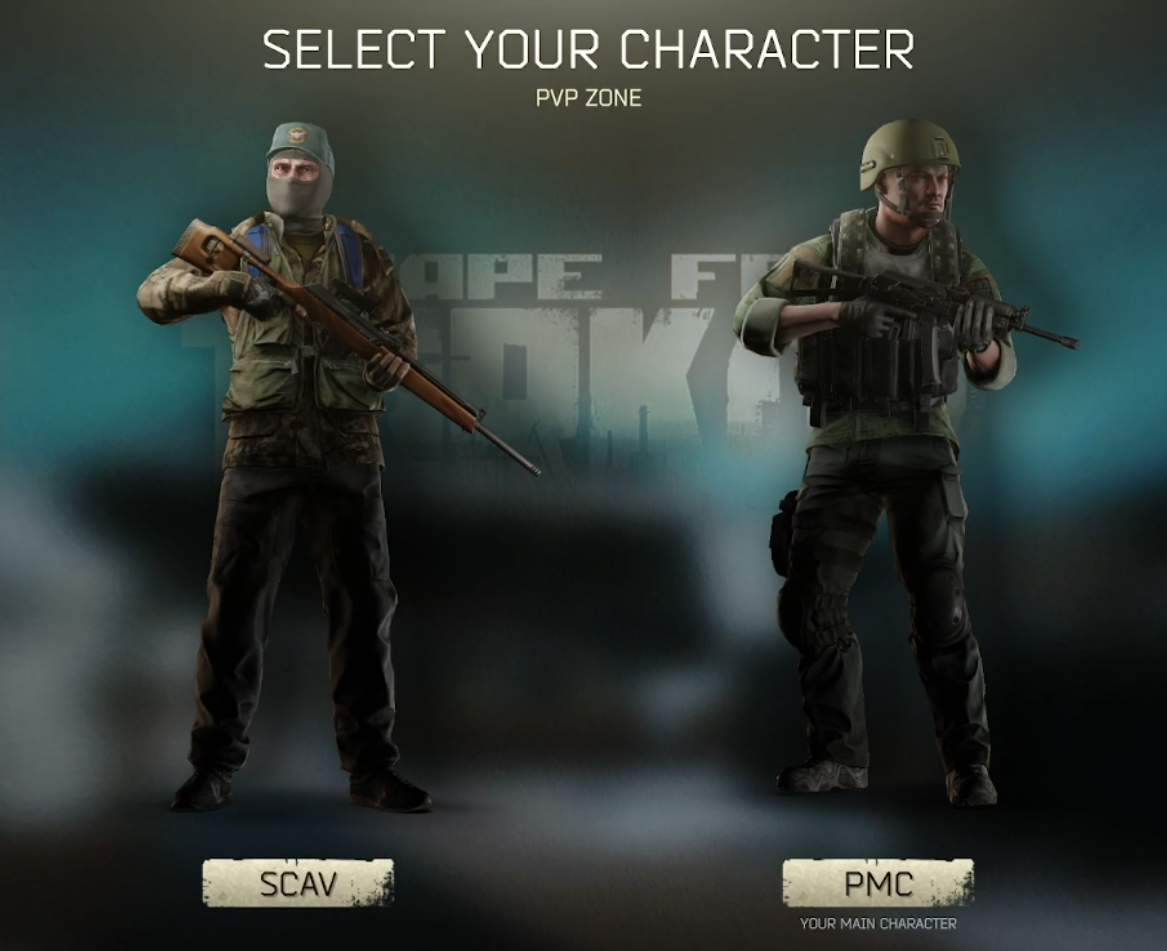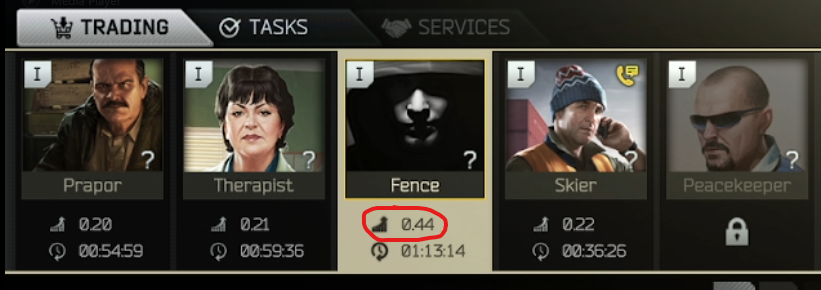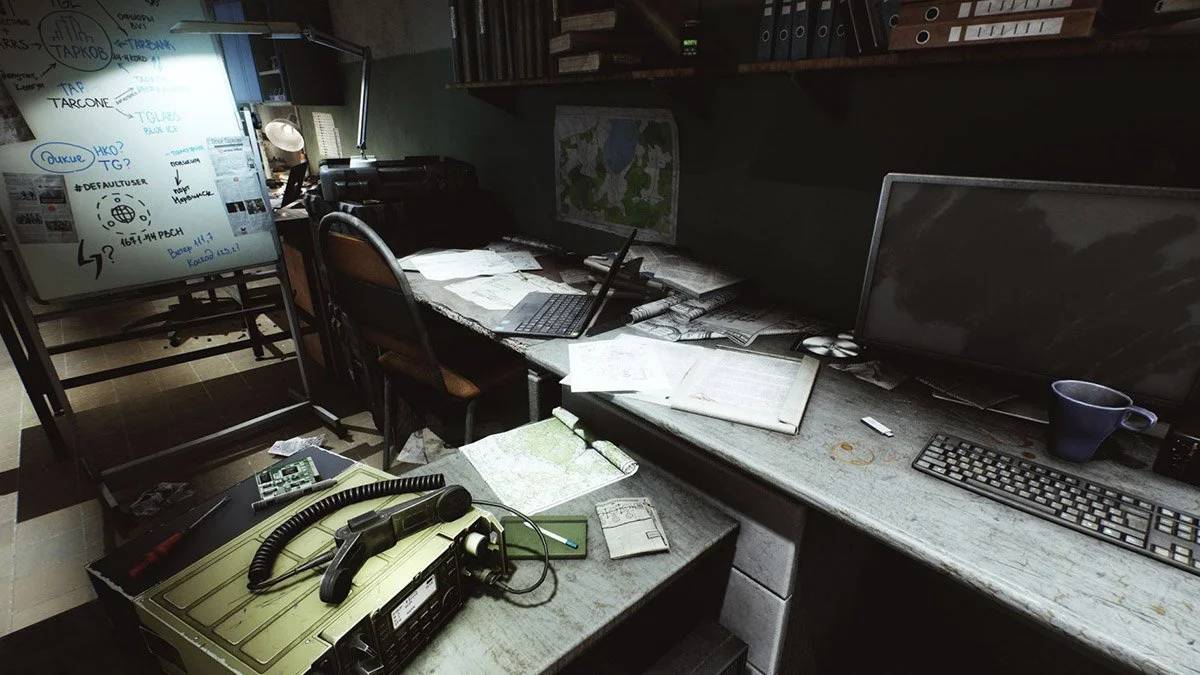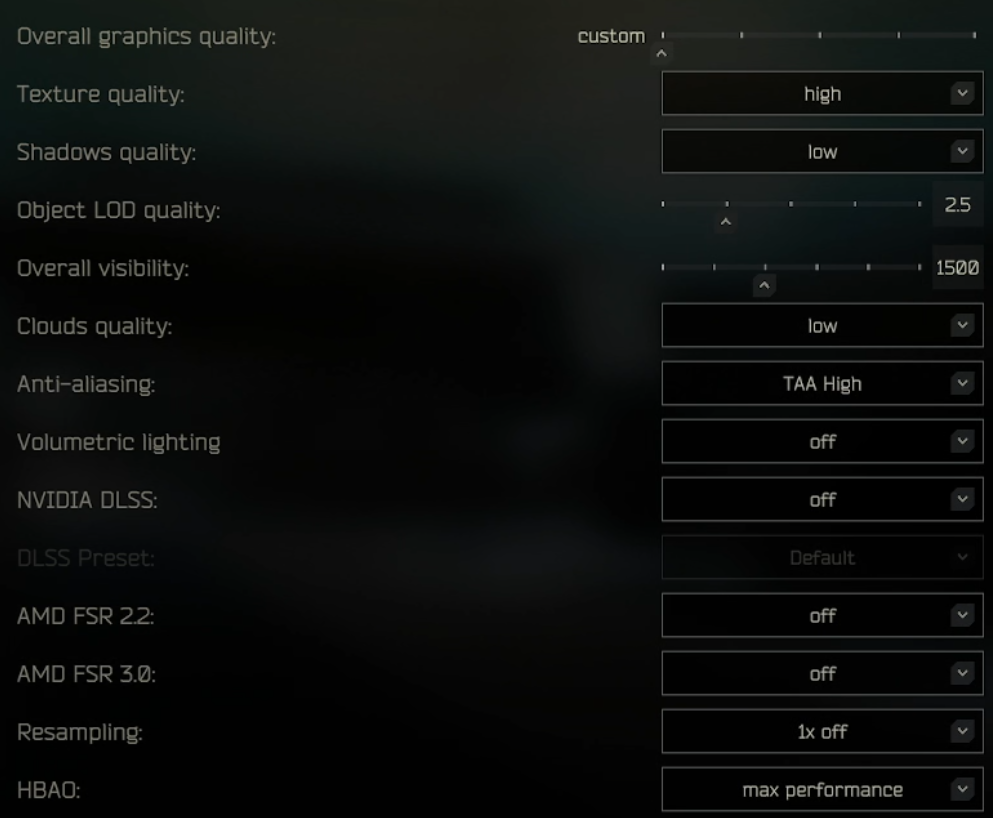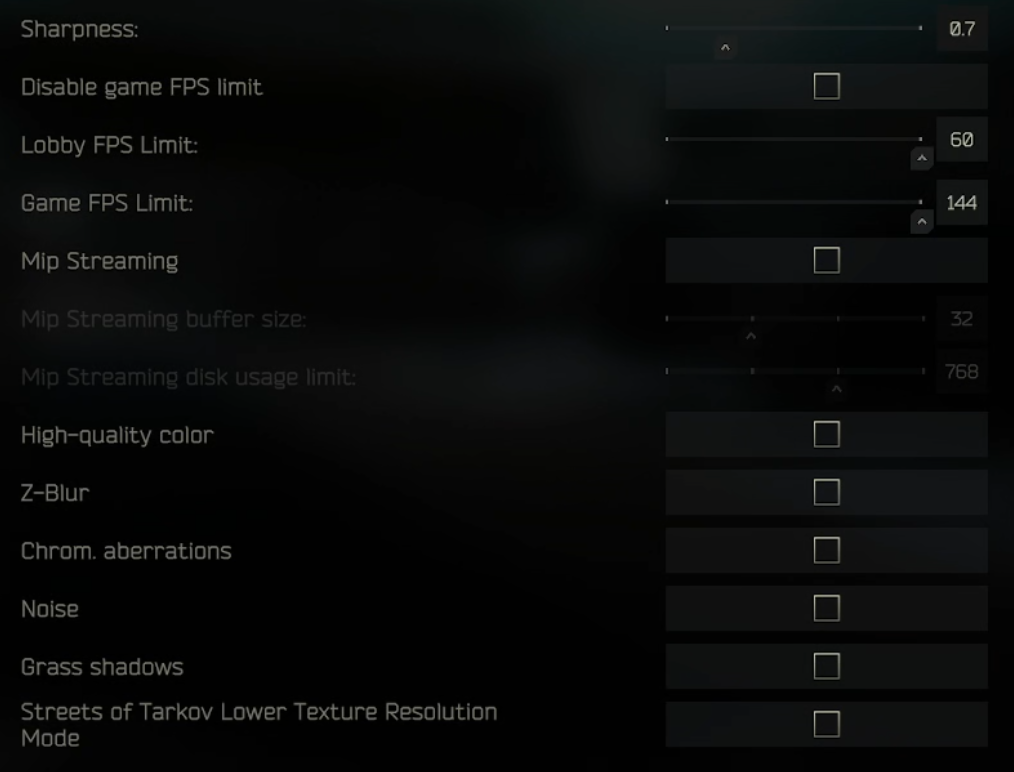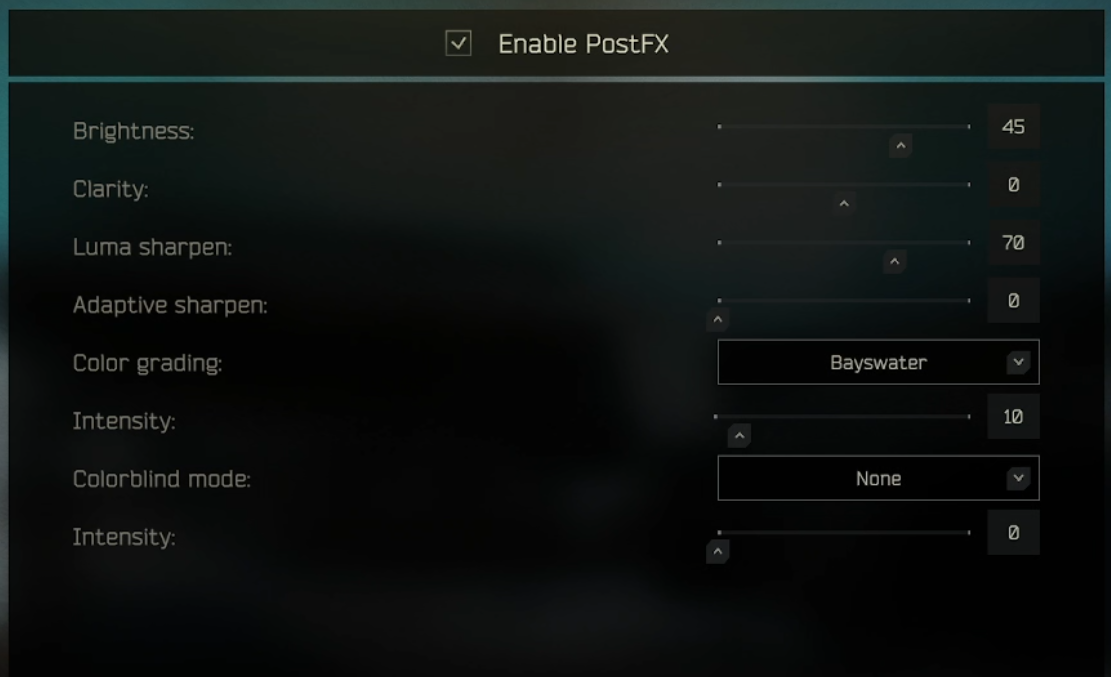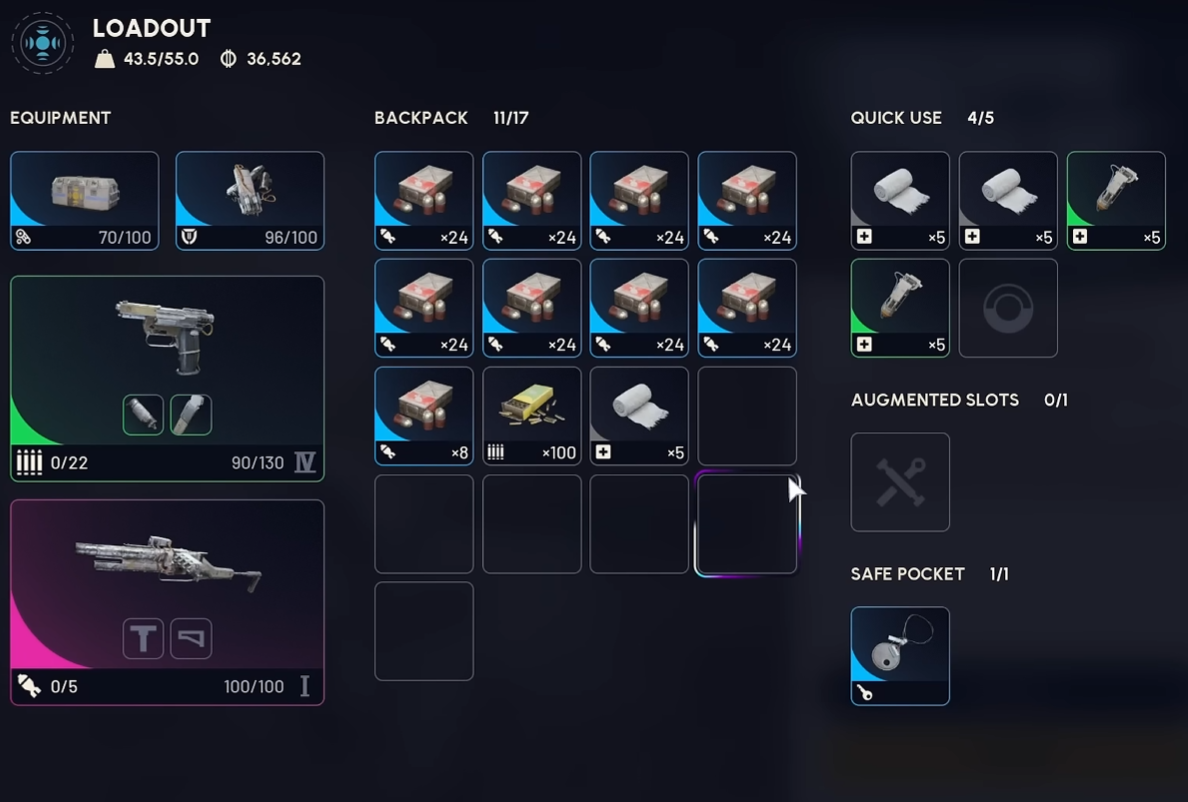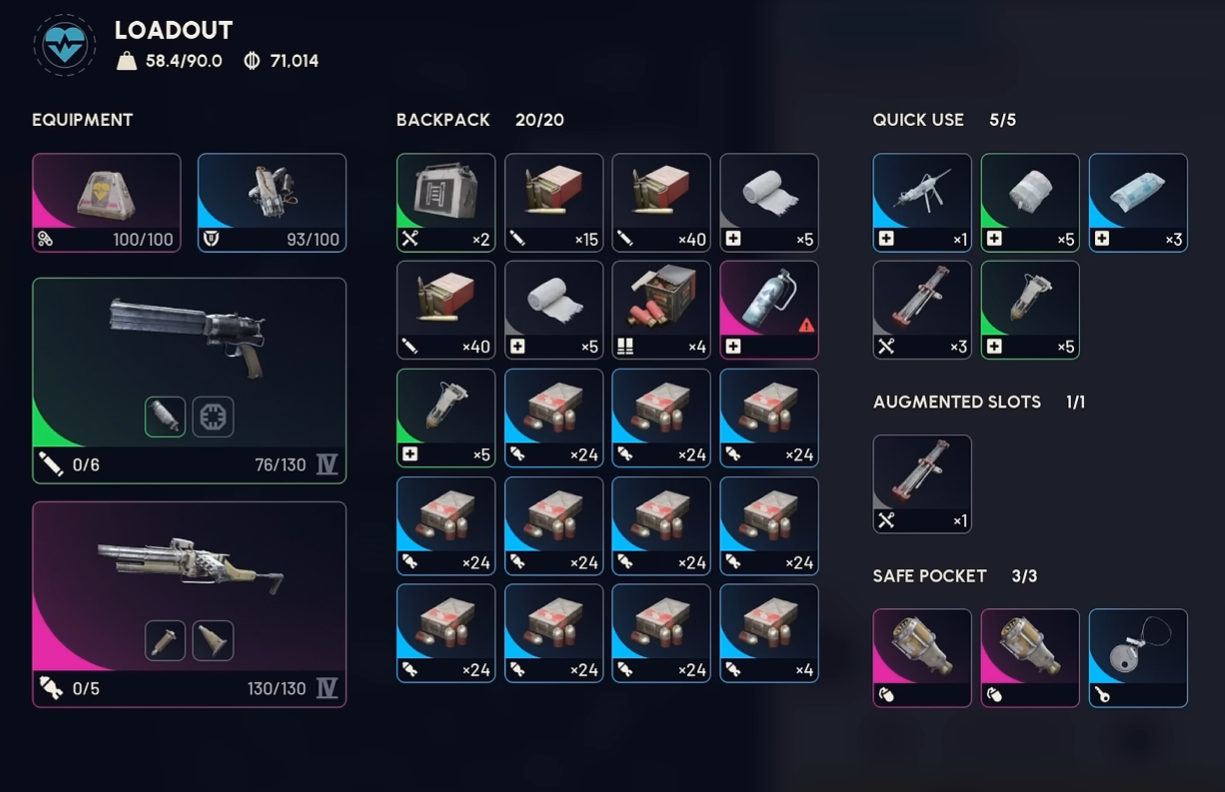Beginner’s Guide to Escape from Tarkov 1.0 — What New Players Need to Know
Escape From Tarkov 1.0 is a hardcore, realistic extraction shooter that’s unlike any other game you’ve played before. In every raid you enter, you’ll face both AI and real players. Your goal is simple — survive, complete quests, collect loot, and escape alive. But don’t be fooled by how simple that sounds. Tarkov has one of the steepest learning curves in modern shooters, and it can feel overwhelming at first.
Escape From Tarkov 1.0 is a hardcore, realistic extraction shooter that’s unlike any other game you’ve played before. In every raid you enter, you’ll face both AI and real players. Your goal is simple — survive, complete quests, collect loot, and escape alive. But don’t be fooled by how simple that sounds. Tarkov has one of the steepest learning curves in modern shooters, and it can feel overwhelming at first.
This guide breaks down the core mechanics, economy, movement, combat, gear, survival systems, and progression — all in friendly, conversational terms. You won’t need to panic. Read on, take notes, and most importantly: be patient with yourself. Everyone starts as a beginner.
💸 Getting Started: Purchasing the Game
Before you jump into Tarkov, you actually have to own the game. There are several editions available on the official Escape From Tarkov website. The most beginner‑friendly choice is the Standard Edition. It’s the digital base game, with a small starting stash and a basic secure container.
Starting with a higher edition can give you larger stash space, extra gear, or early access to features like PvE — but if you’re unsure whether you’ll enjoy Tarkov, start with the Standard Edition. You can always upgrade later. Buying a bigger edition right away can feel like a waste if the game isn’t for you.
Also, when creating your account, use a Gmail address if possible. Some players have reported issues with other email providers during registration in the past, though this may have been fixed.
🧍♂️ Choosing Your Faction: BEAR or USEC
Once you launch the game, you’ll choose between two factions: BEAR and USEC.
BEAR: Russian PMC with Russian voice lines and AK‑style weapon options.
USEC: NATO/Western PMC with English voice lines and Western weapon options. Many beginners choose USEC for comfort and familiarity with the language. You also get a slight bonus on some maps featuring ex-USEC “rogue” AI enemies.
This choice affects your early gameplay and faction quests, and it doesn’t drastically change core mechanics. Pick whichever feels right for you — there’s no “wrong” choice.
🎒 Your First Look: Starting Inventory & Stash
At the beginning, your inventory — called your stash — is small. On a Standard Edition account, you’ll see basic items like:
Weapon with magazines
Armor, rig, and headset
Food and water
Medical supplies
Spare ammo and melee item
Your stash is where you store items between raids. Anything you don’t extract with is lost unless it’s in your secure container — a personal safety net for your most valuable loot. Early on, your secure container is tiny, so be smart about what you protect.
Inside the game menus you’ll also see statistics like level, kills, distance, and survival rate — and the health panel, which shows the status of your character’s body parts. We’ll talk more about that soon.
🧭 Maps, Offline Raids & Practice
Learning the maps is one of the most important early steps to survival. Tarkov maps are big, complex, and full of danger. Offline raids are your best friend when you’re new. They let you:
Explore maps without fear of losing gear
Learn extraction points
Fight AI at your own pace
Understand loot spawns and terrain
To start an offline raid:
Select a map
Check the box for Practice Mode
Adjust AI and settings to your preference (it is recommended to keep them on for practice)
Even if you keep AI on for a “live” feel, offline raids are excellent for learning the layout before facing real players.
🧑🔧 Settings That Help You Survive
Certain settings can make Tarkov easier to play — especially early on.
Quick slots (for meds and grenades)
Stance and health condition displays
FOV and head bobbing
Stamina and fatigue settings
Malfunction handling
For example, binding inspect weapon and check malfunction to easy keys lets you quickly fix jams in the middle of combat. These settings are personal preference, but they help make the action more fluid and less stressful.
📦 Gear & Economy: Fear of Losing Stuff
In Tarkov, you lose what you bring in unless it’s insured or in your secure container. Early on, you’ll die a lot — it’s just part of the game. That’s why many seasoned players encourage budget gear runs instead of bringing high‑end weapons and ammo right away.
Start with:
A modest weapon and ammo
Light armor
Just enough gear to complete quests
Nothing you’ll be devastated to lose
Gearing up too much too early can lead to quick losses and frustration. Instead, think smart: survive, complete tasks, and upgrade when you understand the risks better.
🧠 Scav Runs: Low Risk, High Reward
You’ll unlock Scav runs after playing a bit. In a Scav run, you enter as a different character with random gear — and you don’t lose your main stash if you die. This makes it a valuable source of loot and experience.
Tips for Scav runs:
Use them often early on
Learn map geography
Collect valuable items for your main stash
Increase your Scav reputation for better spawns
This is one of the most risk‑free ways to get valuable items and make progress.
💉 Health, Injuries & Status Effects
Tarkov’s health system is far more detailed than most shooters. Every limb has its own HP, and different injuries affect you differently:
Head and thorax damage can quickly kill you
Limbs and stomach damage slow you down or drain stamina
Bleeds, fractures, and concussions require specific items to heal
Painkillers, splints, and CMS kits are essential for surviving injuries and getting out of raids alive.
🔫 Ammo Matters More Than Guns
One of the first big lessons in Tarkov is that ammo type matters more than weapon choice. Different ammo rounds have varying damage, penetration, velocity, and effectiveness against armor.
The best way to learn ammo:
Inspect the ammo in game
Optionally use ammo charts (online tools are huge here)
Understanding ammo will significantly improve your survivability in fights.
🛠 Hideout & Modding Weapons
As you play, you’ll unlock and build your hideout — a personal space that grants bonuses and allows for weapon modifications. A workbench lets you add parts to guns that change recoil, accuracy, handling, and more.
Modding can seem overwhelming, but start simple:
Focus on essentials like stocks and grips
Experiment to see how each part affects your weapon
Don’t worry about meta builds until later
Remember — good ammo with a basic gun often outperforms fancy parts with poor ammo. First focus on making sure your gun works, maybe by testing it in an offline raid against some Scavs.
🤝 Traders & Progression
Traders are NPCs who:
Give quests
Buy and sell items
Unlock new gear through loyalty levels
As you complete tasks and level up traders, you gain access to better weapons, armor, ammo, and crucially — the Flea Market. The Flea Market lets you buy and sell with other players, which transforms your progression.
Aim to reach the level needed for Flea Market access early — it’s a game‑changer, and you’ll get there sooner or later (level 15).
🚫 Common Beginner Mistakes to Avoid
Here are some traps new players frequently fall into:
Ignoring the map and getting lost (google the map for wherever you are going and have it up on a second monitor or your phone)
Being greedy after a kill and looting a body that is out in the open
Thinking PvP is the main priority at the start
In Tarkov, survival and learning are more important early on than fighting. Focus on finishing raids, completing quests, and gearing up slowly and sustainably.
🎯 Final Thoughts — It Gets Better
Escape From Tarkov is tough — that’s part of its appeal. Expect early deaths, confusion, and mistakes. But with patience and persistence, the game becomes incredibly rewarding. Every survival feels earned. Every quest completed feels triumphant.
So, take your time. Learn the maps. Respect the mechanics. Play smart. And most of all — enjoy the journey.
Good luck out there, and we’ll see you in Tarkov.
Mastering Scav Runs: The Ultimate Guide to Scavving in Escape from Tarkov 1.0
Scav mode transforms the typical high‑stakes raid into something more flexible, allowing you to experiment, learn maps, and gather gear without risking your main stash. Because dying as a Scav doesn’t cost you your PMC’s gear, you can play more freely — useful for both looting runs and reconnaissance. Learning the maps on a scav is much easier than as a PMC.
If you’ve ever felt the sting of losing precious gear during a raid with your main PMC character — and wondered if there was a lower‑risk way to still get loot and practice combat — then Scav runs in Escape from Tarkov (EFT) are your secret weapon. Playing as a Scav lets you step into the raid with random equipment, minimal risk, and the potential to walk away with valuable loot and personal experience.
Scav mode transforms the typical high‑stakes raid into something more flexible, allowing you to experiment, learn maps, and gather gear without risking your main stash. Because dying as a Scav doesn’t cost you your PMC’s gear, you can play more freely — useful for both looting runs and reconnaissance. Learning the maps on a scav is much easier than as a PMC.
In Escape From Tarkov 1.0 you can play as your PMC with equipment from your stash, or as a Scav with random free equipment and items.
What Is a Scav Run in Escape from Tarkov?
Scav mode — sometimes called “scavving” — is a completely separate type of raid in Tarkov compared to playing as your PMC. When you join a raid as a Scav, you spawn in with a randomized loadout rather than bringing your own gear, and you enter the raid at one of several preset spawn points. This gear is usually more modest than a well‑prepared PMC loadout and is in terrible condition, but the trade‑off is that death doesn’t penalize your main character’s stash.
In addition, while you are in the raid as a Scav, you are neutral toward all AI Scavs — meaning they won’t shoot you unless you shoot first. However, if you attack a friendly Scav (player or AI), you instantly become a “traitor,” and all nearby AI Scavs will turn hostile. That makes Scav mode unpredictable, but also a playground for bold — or cautious — players. Importantly, player‑controlled Scavs share that neutral rapport: you can run alongside other human‑Scavs without friendly fire complications — unless someone betrays that trust. Oh but be careful, if you run into any of the game’s bosses, they or their guards might attack you if you simply get close to them, so keep your distance.
Scav mode is an “anything goes” style of gameplay — randomized gear, reduced risk, and unique dynamics that change how you approach combat and looting in Tarkov. Used right, it can be a powerful tool for progression and survival.
The Benefits of Using Scav Mode Strategically
One of the biggest draws of Scav mode is that it lets you expand your stash and gather loot without putting your main PMC gear at risk. When you survive a Scav raid, anything you loot becomes yours to keep — meaning Scav runs are essentially a low‑stakes farm run for loot and supplies.
Beyond just gear, using Scav mode grants you access to features that are unavailable or different for PMCs: things like BTR deliveries or certain quests. When your Scav reputation is high, these perks become significantly better. Not to mention your scav will spawn in with better gear. Scav runs give a great opportunity to learn maps and loot spawns without sweating over losing an expensive PMC kit.
For newer players especially, this is gold — you get to explore and familiarize yourself with maps under far less pressure, which translates to better performance when you go back to PMC raids. Even if you’re not after high‑end gear, you can treat Scav runs as a training ground: understanding map flow, AI behavior, sound cues, and extraction routes, all with negligible risk. In essence — Scav mode offers a flexible, forgiving way to grind, learn, and profit in Tarkov.
Scav Karma: Why It Matters & How to Increase It
In Escape From Tarkov 1.0 your trader reputation for the trader Fence is your Scav Karma.
In Tarkov, your “Scav reputation” — often referred to as Scav Karma — is a hidden yet critical stat tied to your standing with the in‑game trader Fence. Your karma level determines how favorably the game treats you when you play as a Scav.
As your Scav karma rises, you unlock a range of benefits: better starting loadouts, more extraction options, friendlier AI behavior, faster cooldowns between Scav raids, and even improved trader deals when selling loot. High karma essentially turns you from a generic, untrusted Scav into a trusted Tarkov scavenger — making raids smoother and more rewarding.
On the flip side, low or negative karma makes your Scav runs riskier: poorer gear, limited extracts, unfriendly AI, and generally harsher penalties. Because of that, karma is one of the most important metrics to manage if you want long-term success with Scav runs. Checking your karma is simple — it's tied to your Fence reputation, visible in the trader menu — so you can always know where you stand.
How to Increase Scav Karma
Improving your Scav karma isn’t complicated — it rewards consistent, non‑hostile behavior, survival, and teamwork. For example, simply extracting from a raid as a Scav will grant a small positive karma boost. Surviving raids adds up over time: repeated success builds a stable foundation.
Another strong karma-builder is using co‑op or car extractions — taking these extracts sends a clearer signal to the game that you’re playing clean, and tends to give larger reputation boosts. Helping AI Scavs, rescuing them, or assisting Scav bosses/guards when they fight foes also increases karma. Taking down a “traitor Scav” (an NPC Scav that attacked innocents) is another karma-safe kill that can net you a small bonus.
Of course, if you kill a hostile PMC (one that has attacked Scavs), that’s another potential reputation gain. These incremental gains add up — over multiple raids, you can climb the scales from a neutral or low‑rep Scav to a high‑rep “trusted” Scav.
What Reduces Scav Karma
On the reverse side, certain actions can tank your reputation quickly. Killing friendly AI Scavs (or player‑controlled Scavs who haven’t attacked you) carries a moderate penalty. Engaging or killing Scav bosses (or their guards) almost always hurts your karma significantly.
Even killings of player Scavs without provocation can drop your karma steeply and mark you as a rogue — which makes future Scav raids harder. Essentially — whenever you betray the inherent neutrality of Scav mode, you risk losing the long‑term benefits that come with a good reputation. That’s why “hot‑headed” scavving is often a trap: the short‑term thrill of killing a Scav often isn’t worth the reputational cost, especially if you value stable, profitable runs over chaos.
Scav Progression: Cooldowns, Skills & Hideout Upgrades
In Escape From Tarkov 1.0 the intelligence center is great for Scavving.
Scav mode isn’t just about individual raids — there’s a meta‑game around cooldowns, skill progression, and hideout upgrades that rewards players who take it seriously. Each time you use your Scav, the mode goes on cooldown — but higher Scav karma reduces that cooldown timer, letting you raid more frequently. Better reputation also improves the quality of gear loadouts you spawn with, unlocks more extraction options, and increases the likelihood that friendly AI Scavs will cooperate with you. You can ask them to cooperate with you by emoting at them in raid.
Over time your Scav character also “levels up”: surviving raids, getting kills, and earning experience contributes to your Scav’s skill profiles, similar to how your PMC improves. On top of that, the in‑game “hideout” and certain upgrades (like the Intelligence Center) can influence cooldown reductions and overall scav rewards, making long‑term investment worthwhile.
This layered progression — karma, skills, hideout bonuses — turns Scav mode from a throwaway farm run into a viable long-term component of your Tarkov strategy. If you treat Scav runs as a part of your overall growth, you’ll see consistent returns: better gear, more loot, fewer cooldown waits, and a smoother ride overall. Not to mention the Intelligence Center also gives you access to Scav specific daily missions as well, so it is worth building as soon as possible.
Advanced Scav Tactics & Tricks
Once you’re familiar with the basics, there are several advanced tactics that can help you squeeze more value out of every Scav run. One powerful method is to take advantage of co‑op extracts whenever possible — with trustworthy PMCs. Not only does this often grant a better reputation boost, but it also increases your chance for extra loot or bonus rewards upon extract. Using co‑op extracts can also help you avoid early run‑throughs and give time to loot properly. Another strong tactic: maintaining high karma before deciding to go rogue.
Once you hit a stable threshold (for example, around +6 reputation), you can risk more aggressive actions — like targeting a looted player‑Scav — with lower penalty risk, because your accrued karma acts like buffer. Some high‑rep players even wait until they consistently spawn with armor, helmet, and reliable guns before deciding to do ruthless scav runs. Additionally, being mindful of AI‑Scav and boss behavior is often smarter than blind aggression: sometimes letting AI and bosses duke it out while you pick off loot or clean up survivors yields better net gains than constantly engaging.
In other words: use Scav mode not as a chaotic deathmatch, but as a strategic tool — manage karma, control aggression, and pick your fights. That mindset turns Scav runs into one of Tarkov’s strongest long‑term plays.
Common Mistakes Scav Players Make
Even seasoned players can slip up — and when using Scav mode, small mistakes often carry outsized costs. A top mistake is killing Scavs early and often out of greed or boredom: while it might feel satisfying, it destroys karma and ruins future runs by bringing hostile AI and poor spawn gear.
Some players also underestimate cooldown timers or neglect hideout/skill upgrades, making their Scav runs less efficient than they could be. Spending too much time scavving — especially if your goal is to progress your PMC — can drain time and loot potential away from your main character. Finally, many newcomers fail to check their karma/karmic status before acting, and end up accidentally triggering rogue status with no recovery plan.
Being aware of these pitfalls is critical: avoid reckless behavior, track reputation, plan extracts, and treat Scav runs as part of a broader Tarkov strategy — not just a chaotic shooting gallery.
Conclusion: Make Your Scav Work for You
Scav mode in Escape from Tarkov is far more than a side‑option or novelty — when used right, it’s a powerful tool for loot, training, and progression. It offers a low‑risk entry into raids, the chance to experiment with combat and map knowledge, and a steady path toward better gear and reputation. By paying attention to your Scav karma, making smart decisions about combat and extracts, and using hideout/skill progression to your advantage, you can turn Scav runs into a consistent, profitable aspect of your gameplay.
Rather than treating them as chaotic, riskless raids full of chaos and betrayal — consider each run a strategic move in a larger game of survival and growth. Master the Scav system, and over time you’ll see not just better loot, but better survival instincts, more knowledge of Tarkov, and a stronger foundation for your PMC. So load in as a Scav with intention — because every run matters.
At the end of the day if you get too afraid of losing a kit (aka gear fear) just load into a scav and get some stuff for free.
Best Settings for Escape From Tarkov 1.0 – Max Visibility + FPS
If you want to spot enemies sooner, react faster, and stay smooth even on lower‑end rigs, optimizing graphics, postfx, and game settings in Escape From Tarkov 1.0 is essential.
If you want to spot enemies sooner, react faster, and stay smooth even on lower‑end rigs, optimizing graphics, postfx, and game settings in Escape From Tarkov 1.0 is essential. With many post‑processing effects, fancy lighting and render options, the default settings can often hurt visibility or choke frame rate. This guide will walk you through the ideal configuration to boost FPS and make enemies easier to spot — especially useful for competitive players, long raids, or less powerful PCs.
🎯 Core Graphics Settings for Performance & Clarity
The quality graphics settings in Escape From Tarkov.
Texture Quality: Medium – High
Use Medium if your GPU has 6 GB VRAM or less. Use High if you have 8 GB+ VRAM. Lower‑quality textures reduce GPU load but can make nearby detailing muddy.
For highest clarity (especially when looting or checking close objects), Medium–High is recommended.
Shadows Quality: Low
Shadows heavily impact performance and can obscure enemy silhouettes. Low shadows dramatically improve FPS and actually help visibility — enemies in dark corners or behind objects are easier to spot.
Even on reasonably powerful rigs, keeping shadows low is a strong advantage unless you prioritize aesthetics at the cost of gameplay.
Object LOD Quality: 2.0 – 2.5
Object LOD (Level of Detail) controls how detailed objects appear at a distance. Setting it around 2.0–2.5 is the community “sweet spot” — distant objects remain recognizable without overloading GPU/CPU with unnecessary detail.
Lowering LOD reduces rendering load significantly while keeping performance-friendly visuals.
You can always turn it up to the maximum if you have a powerful gaming rig.
Overall Visibility: 1,000 – 1,500
This setting determines how far terrain, objects and players render in the distance. 1,000–1,500 gives a solid balance — far enough to spot threats, but not so far that rendering distant, irrelevant objects kills FPS.
1,000 works well for close-quarters or medium-range engagements; bump up to 1,500 if you snipe or want longer draw distance.
You can always turn it up to the maximum if you have a powerful gaming rig.
Advanced / Optional Graphics Toggles — What to Turn Off (or On)
More graphics settings in escape from tarkov, on the lower part of the menu.
Anti‑Aliasing: Use TAA — gives smoother edges without major FPS hit.
Resampling / Upscalers (e.g. DLSS / FSR): Best to keep Resampling off and avoid using DLSS/FSR unless your system is struggling — upscaling can blur distant things, making enemies harder to spot.
HBAO (Ambient Occlusion), SSR (Reflections), Grass Shadows, Z‑Blur, Chromatic Aberration, Noise, Extra Volumetric Effects — turn these off or to minimum: they mostly add aesthetics but significantly impact performance and sometimes hinder clarity.
NVIDIA Reflex / Low‑Latency Modes — enable if available: this reduces input lag and can improve competitive responsiveness without huge FPS costs.
High-quality color, Z-Blur, Chrom. aberrations, Noise, Grass Shadows - Keep all of these boxes unchecked
Streets of Tarkov Lower Texture Resolution Mode - Turn on only if you get bad performance on the Streets of Tarkov map specifically.
Game Settings & UI: What to Enable / Disable for Clarity
The optimal Escape From Tarkov game settings.
From general community feedback and many player guides:
HUD elements like Stamina, Stance, Health Condition: “Always shown” — these only occupy corners and give critical info without blocking screen center.
Quick‑use bars, inventory overlays, and redundant HUD clutter: Auto‑hide / minimal — helps reduce distractions. Though you can set them to always being on if you want to be able to see your hotkeys at a glance. This is up to personal preference.
FOV: Personal preference — many prefer around 70–75, giving good peripheral vision without distortion. At least 70 is recommended.
Head-bobbing: lower values — reduces unnecessary motion blur or sway that can obscure distant targets. Turn this as low as possible.
Malfunction‑notifications: ON (so you don’t miss gun jams).
These UI tweaks ensure your field of view stays clean and focused — maximizing your chances to spot movement or enemies quickly.
🔧 PostFX Settings for Maximum Visibility in Escape From Tarkov
The best PostFX settings in Escape From Tarkov to see better.
Fine-tuning PostFX settings can make a dramatic difference in how clearly you see enemies in dark corners, indoor environments, and foggy weather. These settings from the screenshot are highly optimized for clarity and visibility while maintaining strong FPS:
These Escape From Tarkov PostFX settings are vital to help you see in dark corners and buildings. They give you a gigantic advantage over someone who doesn’t use them and can’t see in the dark nearly as well as you can.
✅ Recommended PostFX Setup
Brightness: 45
Gives a moderate boost to visibility in shadows and indoor areas without overexposing bright daylight zones. Helps spot enemies in places like Big Red or underground.Clarity: 0
Left at 0 to avoid introducing artificial contrast, which can sometimes cause harsh lighting that hurts long-distance visibility.Luma Sharpen: 70
This is key for enemy clarity — it sharpens only the luminance channel, which enhances definition and edge detection without adding grain or artifacts.
✅ Ideal for spotting enemy silhouettes in dim environments.Adaptive Sharpen: 0
Left off to reduce extra processing and avoid over-sharpening effects that can create haloing or edge flicker during movement.Color Grading: Bayswater
Bayswater is known for its cooler, clearer tone — it softens warm color palettes and makes reds and browns stand out more.
🔍 Excellent for factory, woods, or interchange visibility — especially indoors.Color Grading Intensity: 10
Balanced — strong enough to apply noticeable clarity and hue correction, but not so strong that it looks unnatural or filtered.
Colorblind Mode: None
Unless you have a specific need for colorblind settings, keeping this off ensures no unexpected changes to color saturation or enemy highlighting.Colorblind Intensity: 0
Since colorblind mode is disabled, intensity here has no effect — perfectly configured.
Why These Settings Work — Understanding the Tradeoffs
Escape From Tarkov is known to be CPU‑bound for many players — rendering, object draw distance, LOD, and overall visibility often impact CPU/GPU heavily. Lowering heavy graphics loads frees up resources.
High‑cost settings (shadows, reflections, AO, global illumination, high LOD) often add aesthetic flair but rarely help in a combat situation — and they often obscure enemies rather than highlight them.
Balanced settings area — medium textures, low shadows, moderate LOD & draw distance — give clarity for identifying threats (loot, players, movement) while keeping FPS stable even on mid-tier rigs.
Extra Tips: Performance Boosts Outside Game Settings
Make sure your GPU drivers and OS are up to date — outdated drivers can cause unnecessary FPS drops.
If possible, run the game on an SSD, not HDD — reduces load times when entering raids.
Monitor your RAM usage — if you have 16 GB or less, consider closing background apps to avoid memory pressure (some players treat this like a “RAM cleaner”).
Avoid unnecessary overlays, screen recorders, or streaming software while raiding — these add overhead and can reduce FPS or cause stutters.
Conclusion
Optimizing Escape From Tarkov 1.0 for visibility and FPS is more about making smart trade‑offs than maxing out every graphical slider. Use low shadows, medium/high textures, moderate LOD and draw distance, and enable these recommended post processing effects — and you’ll get a clean, sharp view that reveals enemies sooner while keeping your game smooth.
Your computers’ power may vary, but this configuration offers a solid baseline. From there, tweak based on performance and visual comfort. You’ll likely see improved FPS, quicker looting, and — most importantly — the ability to spot threats before they spot you.
See you in Tarkov. Cheeki Breeki.
How to Defeat the The Matriarch in ARC Raiders Guide
If you’re gearing up for one of the toughest PvPvE encounters in ARC Raiders, then the boss known as the Matriarch is your next major milestone. This guide walks you step‑by‑step through what you need to know—how it attacks, how to prepare, how to hit its weak spots, and how to actually survive the fight and extract with your loot. Follow this and your next run will be far smoother.
If you’re gearing up for one of the toughest PvPvE encounters in ARC Raiders, then the boss known as the Matriarch is your next major milestone. This guide walks you step‑by‑step through what you need to know—how it attacks, how to prepare, how to hit its weak spots, and how to actually survive the fight and extract with your loot. Follow this and your next run will be far smoother.
You may also be interested in:
ARC Raiders Guide: Where to Find Apricots & Lemons for Scrappy Upgrades
Ultimate Guide to the Best Settings in ARC Raiders for Performance, Clarity & Survivability
The Matriarch
The Matriarch in ARC Raiders
The Matriarch represents a top-tier challenge in ARC Raiders:
It has more attack patterns and aggression than previous boss encounters, like the queen.
While its health may be less than the Queen, its danger comes from the sheer variety and speed of its attacks (and the presence of other enemies converging).
It offers high‑value loot—boss materials and blueprint components—so taking it down and extracting successfully is extremely rewarding.
It’s an event‑spawn boss, meaning when you see it in the map, everyone will know and drop in for the kill—so extraction is part of the challenge.
In short: killing it is only half the battle. Surviving the aftermath is just as important. Other players are a threat while you are fighting the Matriarch and afterwards.
Load‑out & Preparation
Weapon of choice
The standout pick is the Hullcracker—a heavy launcher weapon that deals serious damage to large targets and weak spots.
You can bring other weapons (for adds the Matriarch spawns or other players), but design your primary load‑out around the boss itself.
Defensive gear
Use a heavy shield. This grants extra protection when the Matriarch fires bursts of homing missiles or launches AOE attacks, especially during its “final phase”.
Because heavy shields require an augment that supports them and reduce your inventory space, make sure your ammo/heal items are prioritized accordingly.
Ammo & consumables
You generally need less ammo than for previous big bosses (the Matriarch has somewhat lower health). Still, you’ll want a solid stash—about 140 launcher ammo is a good benchmark for the Hullcracker.
Bring more meds than ammo. Healing items and shield recharges become critical when things go sideways (and they often will).
If you can team up with friends, it increases your odds significantly—so aim for that if possible.
Summary load‑out checklist
Primary weapon: Hullcracker
Heavy Shield equipped
~140 launcher ammo (or equivalent high‑damage rounds)
Abundant med/heal supply
Secondary weapon (for smaller ARCs or players)
Squad coordination if you can.
Key Attack Patterns to Know
Understanding how the Matriarch attacks is half the fight. Here are the main move‑sets you’ll face.
Homing Missile Barrages
The boss fires swift homing missiles that track players and blow up with significant damage/area of effect.
If you’re out in the open, these will hit you. A bad spot = wipe.
Tip: Stand behind solid cover. Even good cover may still allow indirect damage (AOE or curved missiles). If you keep taking missile hits, you’re in the wrong position.
Gas Mines / Gas Cloud Attacks
Occasionally it will send out gas mines or barrages which don’t seem to deal direct health damage—but will make you cough, not be able to fire, and may also bring in tremors or flashbang‑style effects.
Stay clear of the gas cloud and avoid lingering in the affected zone.
Flashbang‑style Projectiles
The Matriarch can fire little devices or missiles that act like flashbangs—temporarily blinding you or impairing your vision or ability to aim.
When this hits and players are nearby or doing PvP, it becomes a huge vulnerability.
Summons & Add Waves
As the fight progresses, the Matriarch will call in waves of other ARCs (including high‑threat ones like Rocketeers or Bastions).
These enemy adds can wreck your run if you ignore them: one player reported dying not to the Matriarch itself, but to a spawned Rocketeer.
Intense cover and add‑management is vital.
Impenetrable Shield Phase
At intervals, the Matriarch will activate a blue‑glow shield, during which it appears invulnerable—you cannot damage it until the shield drops.
Use this downtime to heal, reload, move position—or deal with adds.
Don’t waste ammo during this shield phase.
Final Aggression Phase
As the boss nears death, it gets particularly aggressive: more missile barrages, possibly more add spawns, and higher risk to you.
That heavy shield + heal supply become even more critical here.
Weak Points & Damage Strategy
Primary weak spot – Head / Core
The best strategy: aim for the head. Shooting the head will expose the red core inside, which is the highest‑damage target.
Secondary targets – Legs
You can shoot the legs to immobilize or reduce mobility, but the leg armor is heavy and it may take a lot of ammo—less efficient than head core.
If your team is comfortable, you might split: one or two shoot head/core, others handle adds or legs—but head/core is the top priority.
Frontal Armor Plates
The Matriarch has extra plating in the front (under the “horn” or big forehead area). If you break those plates, you get a direct line to the core behind.
Use the launcher to peel armor off quickly.
Summary of damage phases
Break plating or armor (launcher/Hullcracker)
Expose core (head red core)
Exploit core until boss drops
Manage adds + cover + shield phases throughout.
Best Location & Map Strategy
Not all spawn locations are equal. Some maps offer much better terrain, cover, and extraction routes.
Ideal Map – Dam Battlegrounds (‘The Breach’)
This map is highly recommended because of good high‑ground position options and strong cover.
Elevated positions make it easier to dodge homing missiles and maintain sightlines.
The pipeline tower rooftop seems like a particularly good spot.
Secondary Map – Spaceport (Launch Towers)
Another viable map: fight from high position next to Launch Towers, like the control tower. Low risk of being ambushed from many angles.
Avoid – Blue Gate
Blue Gate is less ideal—open terrain, fewer good cover spots.
If you must run it here, gather team coordination and plan extraction carefully.
Positioning Tips
Find solid cover with limited flank routes and good sightlines. If you keep getting hit by missiles or you’re constantly repositioning, you need a better spot.
Choose a spot where you can peek out to fire, then hide when the boss fires barrages.
Have an escape route ready for extraction—or if other players show up.
Cover also protects you from adds and sudden flanks.
Step‑by‑Step Fight Strategy
Drop into match, confirm Matriarch event is active.
Move to your chosen spot (ideally high ground). Setup cover, shields, med/heals accessible.
Begin engagement: Focus on armor/plating using your Hullcracker.
Watch for shield phase: When the blue shield goes up, stop dealing damage, reposition, heal, reload.
Handle adds: When ARCs or boss‑adds spawn (Rocketeers, Bastions), divert at least one member to clear them immediately. If ignored, they will wipe you.
Target head/core: Once plating is stripped, aim for the red core at head region. Deal maximum DPS bursts.
Final phase caution: As boss nears death, it gets more aggressive—missiles, adds, flags for other players to come. Stay disciplined.
Boss explodes → loot spawn: Immediately secure your loot while defending from other players and add spawn waves (Bastions often show up here).
Extract safely: Loot is worthless if you die before extraction. Move with awareness, cover flanks, use barricades/defensive utilities if available.
Extraction & Loot Considerations
Defeating the Matriarch grants Matriarch Reactors (legendary material) which are used for top‑tier weapon crafting.
The extraction phase is just as risky as the fight itself—other players will try to ambush you or third‑party you as you loot. The entire map can hear you fighting the Matriarch and any raider can wait until you’ve won to swoop in for the remains.
Use smoke grenades, barricades, ziplines, and defensive utilities to cover your loot phase.
Always assume someone else wants the loot. Plan accordingly.
Common Mistakes & How to Avoid Them
Insufficient cover / open position → You’ll get hit by homing missiles repeatedly. Move to safer terrain.
Firing during shield phase → Wasting ammo and exposing yourself. Recognize shield phase and stop damage output.
Ignoring adds → Summoned ARCs will overwhelm you if you stay tunnel‑visioned on boss.
Solo runs without preparation → The more players you have, the easier—and the better your survival odds.
Loot phase chaos → Even after the boss is dead, you’re still vulnerable. Don’t relax until you extract.
Conclusion
Take on the Matriarch with the right mindset: preparation + positioning + focus + extraction awareness. If you set up a solid spot, equip a heavy shield, bring the Hullcracker, and understand the boss’s patterns (missiles, gas, flashbangs, shield, summons), the fight becomes manageable. It’s not easy—but it’s absolutely beatable.
Now gear up, gather your squad, pick your perch, and go claim those Matriarch Reactors!
You may also be interested in:
How to Defeat the The Queen in ARC Raiders Guide - Easiest Way Revealed
Taking on The Queen in ARC Raiders is absolutely one of the most thrilling—and rewarding—challenges the game offers. With the right plan, load‑out and positioning you can pull off the kill in surprisingly little time. This guide breaks down exactly how to do it: the bare minimum gear, the ideal load‑out, the best map location and fight strategy, and how to handle looting and escape safely. Whether you’re solo or teaming up, you’ll come away ready.
Taking on The Queen in ARC Raiders is absolutely one of the most thrilling—and rewarding—challenges the game offers. With the right plan, load‑out and positioning you can pull off the kill in surprisingly little time. This guide breaks down exactly how to do it: the bare minimum gear, the ideal load‑out, the best map location and fight strategy, and how to handle looting and escape safely. Whether you’re solo or teaming up, you’ll come away ready.
You may also be interested in:
ARC Raiders Guide: Where to Find Apricots & Lemons for Scrappy Upgrades
Ultimate Guide to the Best Settings in ARC Raiders for Performance, Clarity & Survivability
1. Why you should team up (and why solo is tougher)
Doing it in a trio is much quicker and safer. You’ll kill the Queen in around 5‑10 minutes if your team’s geared and coordinated.
Solo? Expect about 12-15 minutes, and every mistake costs more—it’s riskier.
Her laser attack is deadly; if you go down solo, there’s no friendly revive.
Crossing open terrain alone raises your exposure to other players.
The Queen drops 10‑15 Queen Reactors — and you might not even fit all of them if you manage the kill solo.
Bottom line: If you can run with friends or a group, you’ll spend fewer resources, have lower risk and enjoy the fight more. But if you’ve got the gear and want the solo challenge, we’ll walk you through it.
2. Load‑out Options
A. Bare Minimum Load‑out
Here’s what you’ll need at the very least to make it happen:
A Tier 1 Hullcracker (launcher weapon) with ~200 rounds of ammo. In one run it took about 176 shots (with some misses) to drop her.
A couple stacks of bandages + shield recharges, since you’ll likely get hit by fire or the laser.
A decent shield (blue or better) just to survive the laser.
A Hatch Key (so you can extract with loot).
A PvP weapon + ammo (just in case other players interfere).
Optional: a few door blockers if you’re going to fight inside a closed space (more on that later).
Note: Everything else beyond the launcher ammo is flexible. The only “must‑have” is the launcher with enough ammo.
A bare minimum load out to fight the ARC Raiders Queen.
B. Ideal Load‑out
If you want to make the fight smoother and faster, this is what you’d bring (and what worked for a clean ~12‑minute solo run):
Tier 4 Hullcracker (50% increased fire rate) so you shred her much faster.
A Tier 4 Anvil (or equivalent heavy weapon) for both PvP defence and to deal with smaller enemies that pop up.
Double Wolfpacks (high damage grenades) for rocketeers or adds so you don’t get derailed.
Hatch Key + door blockers so you can fortify your spot and extract safely.
Lots of healing gear + shield recharge items.
Over 200 launcher rounds for the Hullcracker.
In essence: you scale up from “bare minimum” to “real comfort zone” by improving those key weapons, ammo count, defensive gear, fortification tools and extraction tools.
A fully decked out loadout to fight the ARC Raiders Queen
3. Finding the Best Location & Setting Up the Fight
The right fight location can reduce chaos and increase success rate dramatically.
Preferably spawn in a fresh match, not mid‑game. If you spawn with just 20 minutes left or all the players are active, you’re at a disadvantage.
If you spawn on the opposite side of the map, it might be smarter to abort (use Hatch Key) and queue again. Time and risk multiply when you’re far away.
Once you’ve got a good spawn, head toward the designated building area—one example is on the Dam Battlegrounds map (north side, near the broken bridge).
Go inside a building with one or two door entrances you can control. Place door blockers or barricades (deployable cover) on both entrances. This gives you a safe zone, reduces player interference and gives you vantage points.
In that building you’ll have a handful of window ledges you can jump on to shoot from. These window positions become key in the fight.
Strategy:
Use one window as your primary firing angle, jump onto the ledge and fire.
When The Queen engages heavy attacks (rocket barrage or laser), pivot to the far back right window to reload/repulse and reposition.
Alternate between these windows as needed—doing so keeps you covered and maximises DPS.
The windows in the long hallway on the circled portion of the Dam Battlegrounds map here is a good spot to fight the Queen from.
4. Fighting The Queen: Tactics & Attack Patterns
Understanding her attacks and behaviour streamlines the fight.
Attack Patterns
Rocket Barrage (Mortar fire): She fires 2–5 mortars that land and explode after a delay into flaming area. You’ll see/hear cues. Dodge or reposition quickly.
Laser Beam: Deadly if you stay in line‑of‑sight. It can feel like a one‑shot kill. The moment you see it charging, get out of the window line‑of‑sight. Don’t risk extra shots.
Weak Points & Where to Shoot
Her face/head core is a solid target (especially for a straightforward approach).
The joints/legs are also weak spots and may yield faster kills if you target them—but are harder to hit.
If you’re using a high‑rate launcher like the Tier 4 Hullcracker, simply mag‑dumping at her face while staying safe is totally viable.
Step‑by‑Step Fight Routine
Fortify your windowed building with door blockers.
Get ready at the first window ledge.
Take shots at The Queen’s face (or leg joint if you prefer, if you hit your shots you could take her down more quickly).
When she fires the rocket barrage, dodge/move.
When she starts the laser, immediately move into cover and reload.
Return to the primary angle and resume shooting.
Continue until ~150–200 launcher rounds are gone (for solo runs). Then she goes down.
Watch for other players: if you heard “don’t shoot” emotes, be ready.
5. The Loot Phase & Extraction
This part can be the trickiest if you’re not prepared.
The Queen drops Queen Reactors (and other high‑tier loot) — you can get 10–15 of them.
Looting in the open is dangerous: other players may try to ambush you.
Use barricade kits to shield yourself while you grab loot.
Even after the kill, stay alert. Players may pretend friendly, then shoot you.
Then extract using the Hatch Key you brought. Don’t hang around in the extraction zone longer than needed.
6. Solo Tips vs. Team Tips
If Solo:
Make sure you’re confident with the building/angles and your ammo/gear.
Accept that you’ll carry extra resources (ammo, heals) because you have no support.
Be extra cautious of other players.
If in a Team (trio):
Assign roles: one stays at window A, one at window B, one covers extraction/looting or provides PvP defense.
Each bring less ammo/heals—they share the workload.
You’ll clear The Queen faster (5‑10 minutes) and extract with less risk.
Conclusion
Taking down The Queen in ARC Raiders isn’t an impossible task—it just demands preparation, positioning, and discipline. Whether you approach solo for the challenge or with a team for the speed and safety, following this guide gives you the best shot at success. Grab your load‑out, choose your stronghold, know when to shoot and when to duck, secure the loot, and extract. Get out there and claim those Queen Reactors—you’ve got this.
You may also be interested in:



